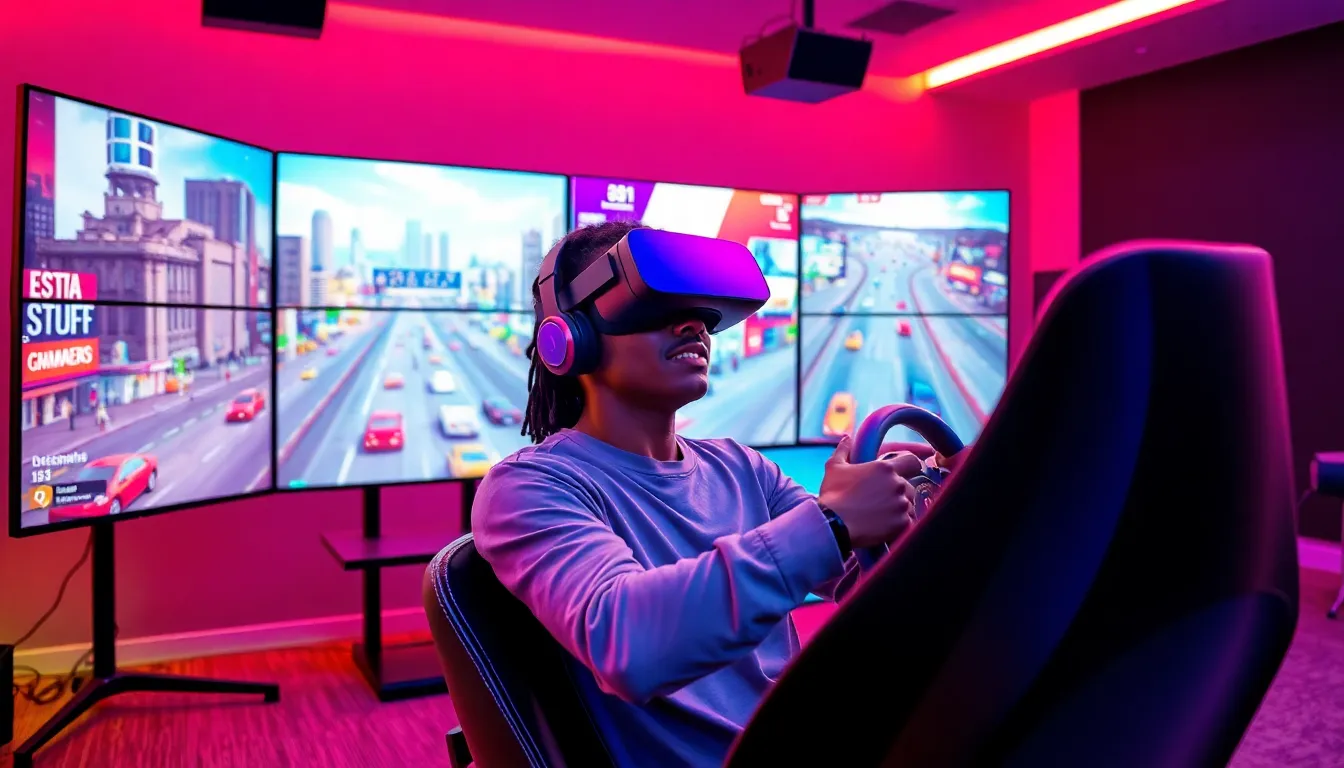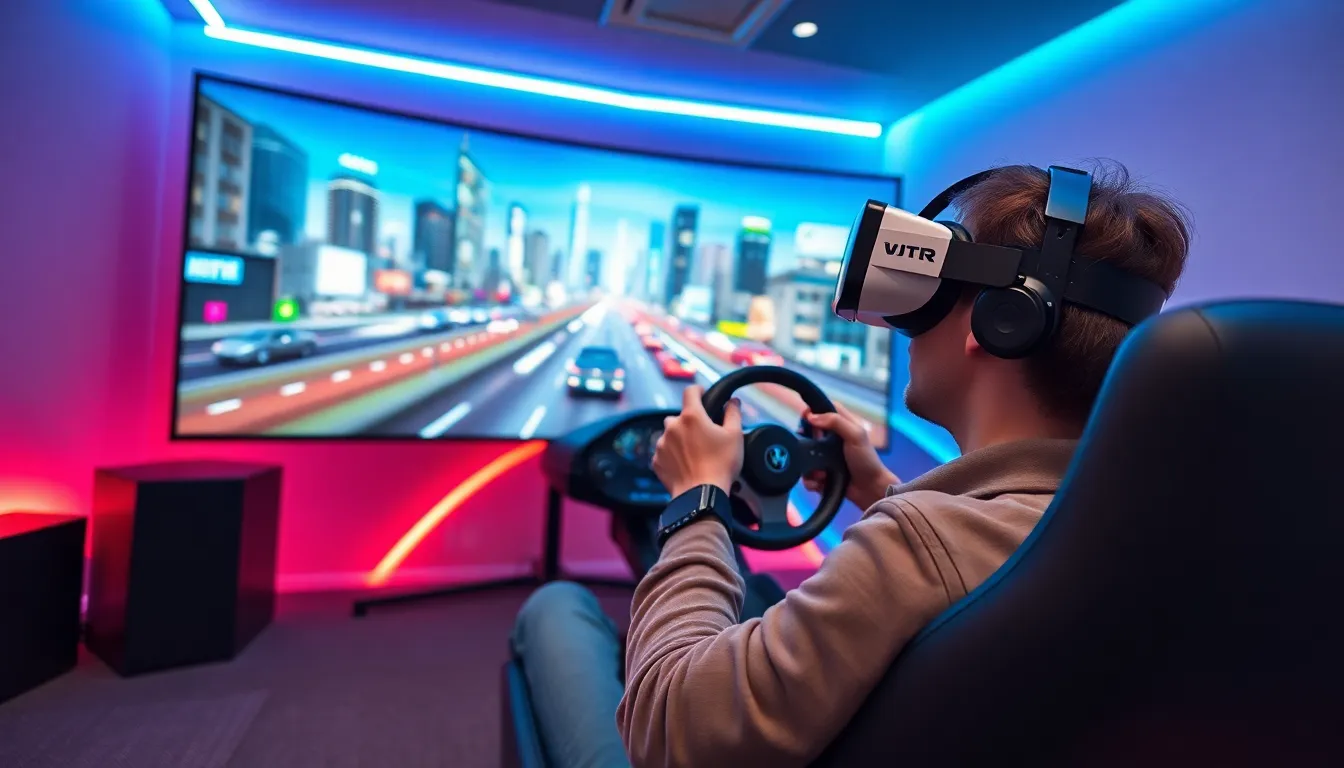In a world where virtual reality transports gamers into realms previously thought impossible, VR driving games take the wheel, and they’re not just steering us around a racetrack. In fact, these games are revolutionizing the way we experience driving, blending entertainment with immersive scenarios that can even make a mundane commute feel like a high-speed chase. Prepare to be captivated and maybe, just maybe, forget you’re not actually behind the wheel.
Table of Contents
ToggleWhat Are VR Driving Games?

VR driving games are simulations that allow players to step into a virtual vehicle and experience driving as if they were in the real world. Using headsets like the Oculus Rift or HTC Vive, gamers are placed in meticulously crafted environments where they can feel every turn and bump through motion tracking and immersive visuals. These games often include realistic physics and an array of driving conditions, from race tracks to city streets, ensuring that the experience is not just visually engaging but also physically stimulating.
But what makes them truly exciting? The capability to drive anything from a fiery race car to your grandmother’s sedan, all while feeling as if you’re truly behind the wheel.
The Evolution of Driving Games in VR
Driving games have come a long way since the days of arcade machines where players would slam buttons to accelerate and brake. The transition to VR represents a paradigm shift, enhancing immersion and realism in ways traditional flat screens simply cannot replicate. Early simulation titles provided rudimentary graphics and steering wheels that often felt disconnected from the action. Fast forward to the introduction of VR, and it’s as though players have been handed the keys to the future.
The late 2010s saw major advancements as developers began incorporating VR technology into existing franchises, leading to titles that not merely dazzled with graphics, but engaged all senses.
From racing simulations to leisurely drives through the countryside, it’s clear that VR has broadened the horizons for driving games, inviting a broader audience to experience the thrill of the ride.
Key Features of VR Driving Games
What sets VR driving games apart from their traditional counterparts? Let’s explore some prime features that rev up the fun:
Immersive Environments
Players can explore photorealistic landscapes, complete with dynamic weather and time-of-day changes that enhance the driving experience, ensuring no two journeys feel the same.
Realism and Physics
Many VR driving games prioritize realistic physics, from tire traction to engine roar. This means players can feel the slight push of acceleration and the effective brakes when they come to a halt, adding a layer of realism.
Customization Options
Gamers often can modify their vehicles with different parts and colors, personalizing their ride and enhancing gameplay.
Multi-player Capabilities
Many titles offer an online multiplayer experience, allowing friends to race each other or simply cruise around together, turning a solitary game into a social outing.
Popular VR Driving Games to Try
With such an exciting genre, it’s hard to pick favorites. But, here are a few standout VR driving games worth checking out:
- Assetto Corsa: This simulation game is renowned for its stunning visuals and extreme realism. Perfect for racing enthusiasts, it’s not just about speed but also about handling complex driving scenarios like a pro.
- Project Cars 2: Offering a diverse range of vehicles and locations, this game pushes players’ driving skills to the limit, all while providing breathtaking visuals.
- Gran Turismo Sport: A staple in the racing genre, this title has embraced VR, allowing players to sit in the driver’s seat of iconic cars across varied environments.
- Driveclub VR: Though its primary game launched without VR, its virtual reality version offers an engaging experience that records every minute detail of driving.
The Benefits of Playing VR Driving Games
The advantages of enjoying VR driving games extend beyond mere entertainment. Here are some noteworthy benefits:
- Enhanced Coordination: Players often need to use their hands, feet, and eyes in tandem to control their vehicle, sharpening coordination skills.
- Stress Relief: What better way to unwind than zooming through scenic routes or racing classic cars? Immersive driving experiences can serve as an excellent stress reliever.
Challenges and Limitations of VR Driving Games
While the immersive nature of VR driving games is groundbreaking, it is not without challenges:
- Motion Sickness: Some players may experience discomfort due to the disconnect between visual feedback and physical sensation.
- Equipment Cost: High-quality VR headsets and accessories often come with a hefty price tag, limiting access to these experiences for many.
- Space Requirements: Playing VR games often requires sufficient physical space to avoid collisions with furniture or walls, which can pose a barrier for many players.
The Future of VR Driving Experiences
What lies ahead for VR driving games? Developers are increasingly focused on enhancing realism through better graphics and physics, while integrating AI that creates unpredictable driving scenarios.
There’s also potential for collaboration with autonomous vehicle technology, providing players with driving simulations that mimic real-world scenarios faced by self-driving cars. AR integration is another avenue being explored, blending real-world navigation into virtual landscapes.




